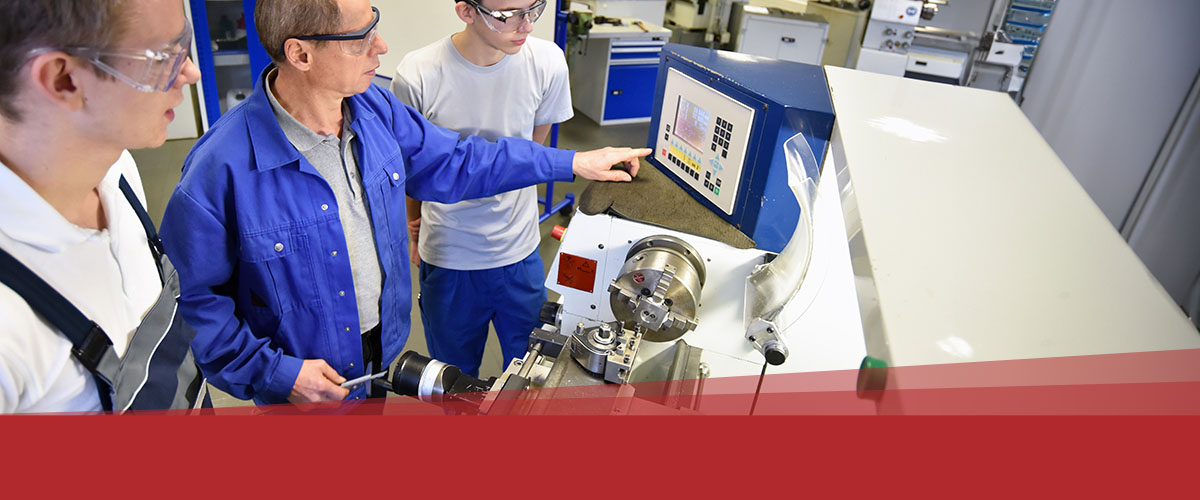

Computer numerical control (CNC) machining has revolutionized manufacturing. Today, CNC manufacturing operates across industries, setting the standard for speed, precision, and tight tolerances. As consumer demand for superior quality and quick turnaround times grows, the CNC machining industry innovates, facilitating parts with increasingly complex geometry at ever-quickening speeds.
With this CNC machining guide, you’ll cover the basics, understand the programming, and learn what to expect in the future.
CNC machining is a computerized manufacturing process in which software and code control machine movements. The CNC machining process is subtractive, meaning objects are shaped by removing material from a workpiece until the desired parameters are achieved.
Design engineers input a complex model into specialized software, which then outputs the code that controls the CNC machines. The machines manufacture the part based on the constraints the programmer outlines in the software. The software automatically generates tool paths, coolant rates, feed rates, and various other parameters to make the part using the materials specified by design engineers.
The language used to code CNC machines is called G-code. Creating a machined part involves rendering a computer-assisted design (CAD) and converting it into computer-aided manufacturing (CAM) software. The CAM software then translates tool paths for the CNC machine. After inputting the program, the operator conducts a test run to identify and correct any errors.
The process is suited to various materials, including metals, plastics, wood, composites, glass, and foam. Each part requires a specific computer program to ensure tight tolerances, machining speed, tool longevity, surface finish, and more.
CNC machining has revolutionized manufacturing, allowing organizations to produce highly repeatable components. It reduces human error, boosts profitability, and promotes quality. Some of the many benefits of CNC machining include:
The CNC machining process comprises multiple computer-powered machining operations, including several mechanical processes. Some of the most common CNC machines include:
CNC mills move rotating multi-point cutting tools to remove material from the workpiece. The process often involves feeding the workpiece to the cutting tool against the rotation, forcing the workpiece against the retaining feature to achieve tighter dimensions. Various milling machines exist to serve different functions, including reamers, face mills, and taps. Basic CNC mills have a three-axis system, although the latest machines can accommodate multiple additional axes.
Drilling uses multi-point drill bits to produce cylindrical holes in the workpiece. Although they primarily work by feeding the drill bit perpendicularly to the plane of the workpiece surface, angular drilling operations are possible with specialized machine configurations. These machines are ideal for drilling holes in materials that hold screws, and they’re common in assembly applications such as automotive parts and electronics.
Many CNC machines operate by rotating the material of the workpiece around a primary axis. Lathe-cutting tools remove the material from the workpiece with precision and speed. CNC lathes are ideal for producing complex designs. Modern CNC machines often incorporate mills and lathes into one machine.
The turning process employs cutting tools to a rotating workpiece. A lathe moves the cutting tool, subtracting from the surface until it reaches the desired diameter. This process produces cylindrical parts with interior and external features.
CNC machines are complex, with many components working together to create the tight tolerances required for manufacturing. They consist of many critical components, some of the most important of which include:
The spindle is the backbone of the CNC machine. It comprises a shaft at the center of the machine’s rotating axis and applies the torque, speed, and control required for successful machining. Machines can have one or multiple spindles depending on the task and application. Many different types of spindles exist for various applications, including metal, stone, and wood cutting.
The input device allows operators to load CNC programs into the machine. They vary depending on the operation, but some standard input devices include:
The input device supplies the code, and the MCU combines hardware and software that reads it and translates it into instructions. It then delivers these instructions to the tool drivers so they can perform the relevant machining actions. The MCU serves as an interpreter, transforming coded coordinates into machine movements and interpreting information from feedback sensors.
A machine tool is any tool that interacts with the workpiece. Depending on the type of CNC machine, they come in several forms, although cutting tools are the most common. Lathes use stationary tools, and the workpiece spins to make cuts. Mills do the opposite, moving spinning tools onto the material. A +4-axis CNC machine is more complex, moving the workpiece and the tool to achieve more detailed finishes.
A machine’s drive system consists of motors that move the machine tools along and around the various axes. A combination of servo motors, ball screws, and linear guides control the CNC machine’s movements and keep them precise.
Successful CNC machining requires complete accuracy and precision. The feedback system is a control measure that verifies and adjusts the machine’s movements, checking the driving system’s accuracy and precision.
Display units give operators insight into each machine, displaying important information on how they interact with various machine functions. They also provide information on the machine’s current operating status.
Modern machine tools focus on speed and precision to meet evolving consumer demands. Suppliers will continue pushing boundaries as CNC machines help manufacturers produce higher-quality results and improve workflow efficiency. The rise of artificial intelligence (AI) can potentially transform CNC machining even further.
At the most basic level, AI algorithms can make predictive maintenance recommendations, leading to improved accuracy, faster production times, and cost savings. From there, AI has the potential to figure out better tool pathing that will reduce processing time and increase quality. These advancements contribute toward a more sustainable production environment.
The integration of AI provides smarter, adaptable machining solutions. Big data analytics can be applied to production data, identifying correlations between production variables and defects and allowing for the prediction of quality challenges before they occur. Early detection paves the way for advanced predictive maintenance strategies. Again, these process enhancements have positive implications for sustainability in manufacturing. CNC machining will continue to evolve to reduce its impact. The future will likely hold more energy-efficient machines, eco-friendly materials, and comprehensive recycling programs to reduce waste.
Successful CNC machining relies on the quality and reliability of machine tool parts. Any component inefficiencies have a significant effect on your overall operations. Setco sets the standards in the design, manufacture, and repair of precision CNC spindles, slides, milling heads, and other. components. Our skilled and experienced technicians can guide you through your CNC machining upgrades, boosting quality and efficiency.
Contact us today to learn more about our quality CNC machining components and services.